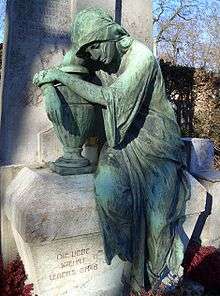Nordfriedhof (Munich)

.jpg)



The Nordfriedhof ("Northern Cemetery"), with 34,000 burial plots, is one of the largest cemeteries in Munich, Bavaria, Germany. It is situated in the suburb of Schwabing-Freimann. It was established by the former community of Schwabing in 1884. It is not to be confused with the Alter Nordfriedhof in Munich, which was set up only a short time previously within the then territory of the city of Munich.
A station on the Munich U-Bahn is also called Nordfriedhof after the cemetery, and the surrounding area is also known locally as "Nordfriedhof" from the station.
The imposing cemetery buildings include a chapel, a mortuary and a burial wall, which was designed between 1896 and 1899 by the municipal architect Hans Grässel. In 1962 a columbarium was added to the north by the architect Eugen Jacoby.
The chapel is described, slightly altered, in Thomas Mann's novella Death in Venice, when the sight of it precipitates a foreboding of death in the protagonist.
Selected burials
- Peter Paul Althaus, poet of Schwabing
- Herb Andress, actor
- Annette von Aretin, first female announcer of Bayerischer Rundfunk
- August Arnold, film producer and director
- Karl Arnold, caricaturist in the journal Simplicissimus
- Philip Arp, actor, cabaret performer, author and theatre director
- Gert Bastian, brigadier-general, symbolic figure of the peace movement
- Fritz Benscher, actor and quiz master
- Otto Bezold, politician
- Franziska Bilek, caricaturist and artist
- Louis Braun, professor and historical painter
- Beppo Brem, folk actor
- Georg Britting, writer
- Christine Buchegger, actress
- Franz von Defregger, artist
- Hans Dölle, legal academic
- Sammy Drechsel, sports reporter and cabaret performer, and his wife Irene Koss, actress and the first television announcer in Germany
- Constanze Engelbrecht, actress
- Oskar Eversbusch, professor of ophthalmology
- Theodore Feucht, painter
- Josef Flossmann, sculptor
- Leonhard Frank, writer
- Hermann Frieb, resistance fighter against the Nazi regime
- Marie Amelie von Godin, writer, supporter of women's rights and Albanologist
- Günter Freiherr von Gravenreuth, lawyer
- Klaus Havenstein, cabaret performer and actor
- Johannes Heesters, actor and singer
- Trude Hesterberg (Schönherr), cabaret performer
- Heinrich Hoffmann, Hitler's official photographer, with his daughter Henriette von Schirach
- Kurt Horwitz, actor, director at the Munich Kammerspiele, director of the Bayerisches Staatsschauspiel
- Peter Igelhoff, musician, composer of pop music and jazz
- Günther Kaufmann, actor
- Eduard von Keyserling, writer (grave 25-4-1)
- Kathi Kobus, landlady of the Alter Simpl
- Wolfgang Koeppen, writer
- Oskar Körner, killed during the Munich Putsch, Second Chairman of the NSDAP
- Otto Kurth, actor and director
- Inge Latz, composer and musical healer
- Hermann Lenz, writer
- Ernst Mach, physicist and philosopher
- Ferdinand Marian, actor (grave now removed)
- Georg Marischka, actor and director
- Anton Neuhäusler, Bavarian dialect poet
- Peter Pasetti, actor
- Ludwig Petuel senior and junior, industrialists
- Toni Pfülf, SPD politician
- Bally Prell, performance artist
- Sebastian Osterrieder, sculptor, Krippenwastl
- Theodor von der Pfordten, killed during the Munich Putsch (in family grave)
- Hans Pössenbacher, actor
- Mady Rahl, actress (grave 178-U-66)
- Anton Riemerschmid, founder of the first German business school for girls
- Barbara Rudnik, actress
- Wilhelm von Rümann, sculptor, formerly in the Alten Vereins-Urnenhalle (urn now secured)
- Arnulf Schröder, actor
- Carl-Heinz Schroth, actor
- Oswald Spengler, political philosopher
- Heinz-Günter Stamm, actor, radio and theatre director
- Fedor Stepun, philosopher and sociologist
- Karlheinz Summerer, Roman Catholic chaplain for the Munich Olympics, 1972
- Siegbert Tarrasch, chess player, theoretician and writer
- Kurt Weinzierl, actor, cabaret performer and director
- Frederic Vester, biochemist, environmental expert and writer
- Albert Weisgerber, painter
- Annemarie Wendl, actress
- Otto Wernicke, actor (grave now removed)
- Josef Wittmann, church painter
- Karoline Wittmann, painter
- Paul Wittmann, sculptor
- Eduard Zimmermann, journalist and television presenter
- A mass grave for 2,099 victims of aerial bombardment during World War II has been converted to form a "grove of honour for air raid victims" (Ehrenhain für Luftkriegsopfer), with a monument by Hans Wimmer.
Sources
- Gretzschel, M., 1996: Historische Friedhöfe in Deutschland, Österreich und der Schweiz. Das Reiselexikon. Munich: Callwey ISBN 3-7667-1233-0
- Scheibmayr, E., 1985: Letzte Heimat. Persönlichkeiten in Münchner Friedhöfen 1784–1984 (1st edition). Munich: Edition Scheibmayr [1]
Continued by:
Wer? Wann? Wo? Persönlichkeiten in Münchner Friedhöfen. (Teil 1/3, Ergänzung zum Grundwerk und Fortschreibung bis 1989). Munich: Edition Scheibmayr 1989 ISBN 3-9802211-1-3
Wer? Wann? Wo? Persönlichkeiten in Münchner Friedhöfen. (Teil 2/3, Ergänzung zum Grundwerk und Fortschreibung bis 1996). Munich: Edition Scheibmayr 1997 ISBN 3-9802211-3-X
Wer? Wann? Wo? Persönlichkeiten in Münchner Friedhöfen. (Teil 3/3, Ergänzung zum Grundwerk und Fortschreibung bis 2002). Munich: Edition Scheibmayr 2002 ISBN 3-9802211-4-8
Notes and references
External links
| Wikimedia Commons has media related to Munich Nordfriedhof. |
- Nordfriedhof on the website of the City of Munich (German)
- Friedhof.stadt-muenchen.net: graves of well-known people at the Nordfriedhof (German)
- Graves of those associated with the Nazi era at Nordfriedhof (English)
Coordinates: 48°10′30″N 11°36′10″E / 48.175°N 11.602778°E